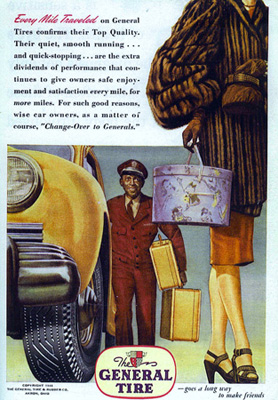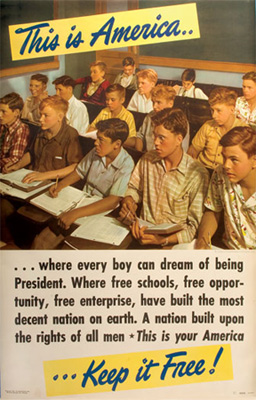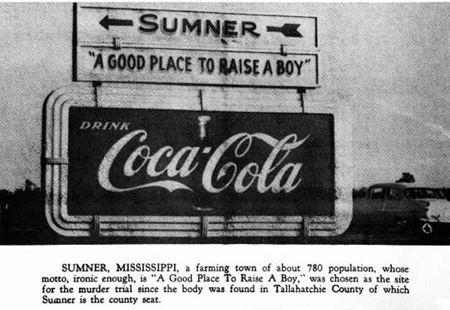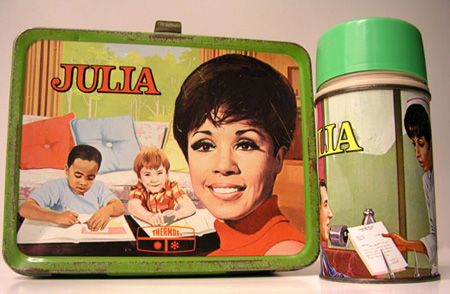Hyperrhiz 10
Maurice Berger, For All the World to See: Visual Culture and the Struggle for Civil Rights
Diane Kuthy
University of Maryland Baltimore County
Citation: Kuthy, Diane. “Maurice Berger, For All the World to See: Visual Culture and the Struggle for Civil Rights.” Hyperrhiz: New Media Cultures, no. 10, 2013. doi:10.20415/hyp/010.r04
Abstract: Review of Berger, Maurice. For All the World to See: Visual Culture and the Struggle for Civil Rights (exhibit). Baltimore: Center for Art, Design and Visual Culture, University of Maryland, Baltimore County. Nov. 20, 2012.
Entering the exhibition For All the World to See: Visual Culture and the Struggle for Civil Rights, the viewer first encounters a large red wall of introductory text with a 20-inch TV size screen in the center showing a 56 second film clip of the CBS documentary The Weapons of Gordon Parks. Shot in black and white16mm, it was first aired primetime on April 16, 1968, twelve days after Martin Luther King's assassination. The segment begins with a close shot of a single lens reflex Nikon camera fitted with a high-powered telephoto lens. As the camera pans out, a high-rise vantage point is revealed through a large window taking up more than half of the frame. Life magazine is inconspicuously left on the table along with a coffee cup and several rolls of film. The ubiquitous red framing the screen and our view connotes the magazine covers of Life, Time and Ebony, the border of the Black Panther logo design and the placard text I AM A MAN. Gordon Parks, the highly celebrated Black photographer and filmmaker, resolutely loads his camera and aims it at the world.
The exhibition examines the historic role of visual culture in the fight for racial justice in the United States from the late 1940s to the mid-1970s, both within the Civil Rights Movement and in mainstream culture. Curated by Maurice Berger and organized by the Center for Art, Design and Visual Culture, University of Maryland, Baltimore County in collaboration with the Smithsonian National Museum of African American History and Culture, Washington, D.C., the project includes an online exhibition and film festival, a comprehensive catalogue, traveling exhibition and K-12 educational resources. Many of the material culture objects on display and downloadable through the online exhibition were painstakingly amassed for years by Berger through purchases on E-bay and include political buttons, photographs, posters, toys, pamphlets, comic books, magazines, newspapers as well as film and television clips.
Historically, a multitude of cultural myths have been created and adapted to reconcile the fundamental contradiction between the espoused ideals of freedom and liberty in the United States and the country's legacy of slavery as evidenced by the persistent racial caste system. America's path from segregation towards racial integration during the Civil Rights Movement was fraught with white ambivalence and fear but also provided unprecedented opportunities for cultural interventions. Berger argues that civil rights activists were skilled image-makers who harnessed the tremendous power of new media and the technologies of the day to shape and garner support for racial justice. He demonstrates that the war against racism was as much a struggle for visibility against the dominant society's need to obscure and control black representation as it was a political struggle fought through civil disobedience, legislative initiatives and political representation. For All The World to See focuses on myriad ways visual images and artifacts construct, perpetuate, disrupt and counter cultural myths. The exhibition consists of five sections: 1. stereotypical images of blacks before the modern Civil Rights Movement; 2. positive images fostering a sense of pride; 3. images of the struggle for racial justice that helped change public perceptions; 4. entertainment television; and 5. artifacts exemplifying multiple threads of representation during the late 1960s and 1970s.
Advertisements before the civil rights movement rarely included Blacks and when they did they reinforced the racial hierarchies by emphasizing privilege and luxury afforded to whites. The General Tire and Rubber Company advertisement of 1948 (Figure 1), exemplifies the strategy of marginalization used to underscore luxuries obtainable through the buying privilege of whites. In the background center of the advertisement is a smiling Black porter encumbered with several suitcases in each arm yet moving quickly to keep up with a fur clad woman in the foreground rendered so large that her head is cut off from the picture plane. Several paces ahead the woman's gloved hand delicately carries a hatbox and her well-heeled white legs are casually crossed, patiently and confidently awaiting the compliant porter. They reflect her habitus of distinction (Bourdieu 85). Pictured on the opposite side of the advertisement there is an illustration of a car from a low vantage point with accentuated tire tread patterns providing a symbolic and formal balance to the woman. The car functions literally and figuratively to obstruct the porter's mobility and reinforces the social distance between white employer and black employee.

Whiteness has historically been conflated with the concept of American. Where Every Boy Can Dream of Being President (from the series This is America, 1943) (Figure 2), exemplifies the conflation. An entire classroom of attentive white boys is actively taking notes with their gaze turned towards the front of the room. The poster's headline text reads: "This is America. ... Keep it Free! [In smaller print] ... where every boy can dream of being President. Where free schools, free opportunity, free enterprise, have built the most decent nation on earth. A nation built upon the rights of all men. This is your America." In the contexts of the exhibition, the viewer fills in the ellipses of the image as well as the text.

In stark contrast is a film segment from Take This Hammer, a 1963 documentary that closely examines racialized practices in the so-called progressive city of San Francisco. Aired on a local educational channel, it aimed to make visible the obscured yet widespread racial prejudice in many northern cities. In the short clip James Baldwin speaks to a group of Black youth about the possibility of a black president. One student maintains that there will "never be a black president." Baldwin answers, "There will be a negro president", when Blacks refuse to internalize the negative messages of the dominant culture and embrace their power. The full 45 minute documentary is available through a link from the online exhibition. Through images and in the exhibition catalogue, Berger traces Black leaders such as Du Bois who understood the revolutionary power of positive visual imagery to counteract negative stereotypes perpetuated in mainstream culture (92). In the NAACP publication The Crisis, Du Bois skillfully used the complex interplay of positive and negative imagery by juxtaposing examples of racial discrimination with representations of Blacks that challenged the status quo.
Positive imagery alone could not resolve the problem of racism. The decision of Emmet Till's mother, Mammie Till Bradley, to let national media bear witness to her son's mutilated body in order to make visible the devastating effects of segregation represents one of the most powerful and persuasive visual moments of the Civil Rights Movement. Although the mainstream press deemed the image inappropriate for publication and refused to print it, black periodicals widely circulated the photo, mobilizing a new generation of black activists. According to Roland Barthes, a photographic image generally functions to reassure or integrate contradictions for the reader. He maintains that truly traumatic images are rare and may have the capability to suspend language, block meaning and disrupt myth (30).
Complete Photo Story of Till Murder Case, 1956 (Figure 3), a twenty page self-published booklet by the photographer Ernest C. Withers, tells the story of Till's brutal murder and the murder trial through images and written text. Withers' booklet challenges the reader to look closely at the photographs and the accompanied written text to glean the signification of the visual details. A shot of a Coca-Cola billboard exemplifies this effect: The billboard's meaning is transformed by the text of an attached plaque which reads, "Sumner, A Good place to Raise a Boy" Ironically, Sumner is the town of Till's trial where an all-white male jury acquitted his murderers.

The ascendancy of television was concurrent with the Civil Rights Movement and was crucial for documenting and galvanizing support in the struggle for civil rights. Television attracted young, socially progressive individuals who creatively explored the new media and were often sympathetic to the fight for racial justice. New technologies of the 16mm hand-held camera and satellite broadcasting enabled news stories to be delivered quickly and more comprehensively to large simultaneous audiences. A four-minute segment of CBS's full day coverage of the historic 1963 March on Washington is among the televised footage included in the exhibition.
Entertainment television was also an important site for Black visual representation. Many variety shows regularly showcased black performers. The structure of back-to-back separate acts was less threatening for whites and gave black performers a national stage. Julia was the first positive non-stereotypical black role on television. Although Julia was an innovation in Black representation, it did so in ways that did not intimidate white audiences. Julia rarely interacted with black friends or colleagues; she readily alleviated white anxiety and did not exhibit racial awareness. Julia's character — intentionally white washed and racially neutralized — may represent one of the first perpetuations of the prevailing post-civil rights racial myth of colorblindness. The exhibition includes a Julia doll and a metal lunch box with thermos, a testimony to the program's wide appeal and selling power (Figure 4).

Countering the myth of unencumbered integration, Malcolm X readily utilized television, magazine and newspapers to champion Islam and Black Nationalism. His carefully fashioned persona underscores his attractiveness, intellect and sophisticated speaking voice. A short clip from City Desk, March 17, 1963, WMAQ Chicago, demonstrates Malcolm X's tremendous rhetorical gifts and charismatic style. In the clip the interviewer attempts to get Malcolm X to reveal his last name. He calmly insists that he does not know his last name because his ancestral name was taken away by slave owners. He and the interviewer have a back and forth with Malcolm X speaking decisively each time. Malcolm remains in charge, speaking forcefully yet without raising his voice until he conveys his message. In the last section of the exhibition Berger presents a wide range of visual culture from the late 1960s and 70s that reflects integrationist ideals as well as the black power and black art movements' principle of cultural self-determination.
The exhibition aptly ends with a large screen playing a 4 minute and 10 second loop of family photographs chronicling ordinary life. Taken by amateur photographers from 1935-1975, the snapshots make visible the rich complexity of everyday life impossible to capture through mainstream media's representations. Edited with fade in and out transitions that are commonly available in programs free through the Internet, they suggest the current struggle and future possibilities of representation for Blacks. We have witnessed the blurring of public and private spaces through the Internet, the election of the first black president, the photos of the Obama family broadcast globally and the conflation of criminality with images of young black men. If wearing a hoodie in the wrong context is a matter of life or death and if "more African-American adults are under correctional control today ... than were enslaved in 1850" (Alexander 180), the relation of visual culture, technology and civil rights is at least as complicated as it ever was.
Works Cited
Alexander, Michelle. The New Jim Crow, Mass Incarceration in the Age of Colorblindness. New York: The New Press, 2010. 176-192.
Barthes, Roland. Image Music Text. New York: Hill and Wang, 1977.
Berger, Maurice. For All the World to See: Visual Culture and the Struggle for Civil Rights. New Haven: Yale University Press, 2010.
Bourdieu. "The forms of capital." Sadovnik, A. Sociology of Education. New York: Taylor & Francis Group, 2007. 83-95.
Notes
- Titles used in the exhibition: 1. It just keeps rolling along: The status Quo; 2. The culture of positive images; 3. "Let the World See What I've Seen": Evidence and Persuasion; 4 Guess Who's Coming to Dinner: Broadcasting Race; and 5. In Our lives we are Whole: The Images of Everyday Life.